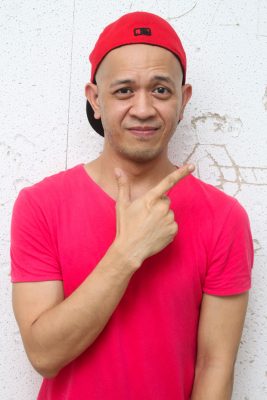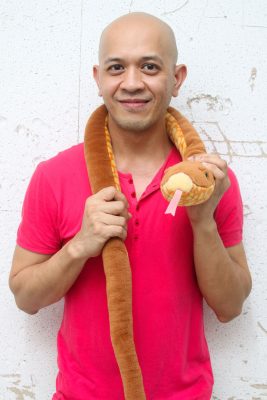As we sit down in the Filipino Department to interview Aristotle Atienza, he defers our first question with a dry, “Ako muna ang may question—bakit ako?” (Wait, I’ve got a question first—why me?)
He has a point. After all, Atienza is just one of many iconic Filipino teachers in the Ateneo. Among the department’s distinctive personalities are award-winning writers Alvin Yapan, Edgar Samar and Michael Coroza as well as seasoned thespians Ariel Diccion, Jethro Tenorio and Banaue Miclat.
However, Atienza presents a paradox: while you hear a number of near-fanatical stories about his wacky and brilliant classes, he’s not as famous (or infamous) as some of his colleagues. If you were never his student, you might have never heard about him.
And yet the stories keep coming—stories of unconventional bonus questions like “Does Horacio de la Costa’s statue have his left hand over his right hand or vice versa?” and “How many holes are there in a SkyFlakes cracker?”
He also has this trademark remark, “Winner!”, whenever he likes a student’s answer—and this word can also describe this teacher who turns routine subjects into something more.
The makings of a winner
But what’s interesting is that despite all the “winner” stories we’ve heard, Atienza remains self-effacing. He insists that there are a lot of professors better than him, and jokes that his life is “sad” because it seems everything he does is related to teaching. In fact, he was apprehensive when we told him there would be a photographer in our interview.
Despite early inspiration from his high school English teacher to pursue his love for literature and desire to go into theater or film, Atienza took up BA History at the University of the Philippines (UP) Diliman. After years of indecision, he shifted to BA Philippine Studies to major in Art Studies and Philippine Literature. Atienza then applied to UP Los Baños and UP Baguio to teach humanities.
After a self-proclaimed “disastrous” teaching demo in the latter school, he applied to the Ateneo back in 2005. It seems he had come full circle: he’s been teaching literature in the university ever since.
When asked about his secret to passionate teaching, Atienza answered in Filipino, “I don’t know if this sounds like a Miss Universe answer, but there’s a lot that I learn from the students … Whenever we discuss pop culture, they know more than I do to the point that I feel vulnerable.”
It’s an odd statement. If anyone would seem to be an expert on pop culture, it would be him. During our interview, he supplemented stories of his life with references to films. In class, he teaches complex concepts by framing them through current TV shows or films to get his point across.
He spends a lot of his free time looking up student-recommended media to use in class. For example, he cites the Filipino-American contestants of So You Think You Can Dance, Marko Germar and Tadd Gadduang, as examples of multiculturalism.
“He does his best not to give the usual by-the-book lecture,” Aimee Capinpuyan, a former student of Atienza, shares. “One time, he made us go around the campus taking pictures of random things. And on our last day of classes, we had a fiesta!”
At the same time, Atienza remains apprehensive about being labeled an “entertaining” teacher. He says, “A fellow teacher said, ‘teaching is sometimes a performance,’ but what’s dangerous about this is for students to see it only as a spectacle.”
This is a real issue in school: students pick teachers based on the amount of jokes they allegedly dish out in class instead of looking for the depth of insight or value of content they offer. With this knowledge, Atienza seeks to strike a balance: performance that’s profound.
What’s dangerous about [viewing teaching as a performance] is for students to see it only as a spectacle.
– Aris Atienza, Filipino professor
Of norms and jejemons
As Atienza demonstrates, Filipino classes have a lot to offer. However, many students still see the Filipino curriculum—along with the other core subjects—as mandatory drudgery. Atienza confirms this when we bring it up, explaining how hard it is to combat students’ preference for Western culture.
Perhaps this problem has its roots in the prevailing perception of Filipino culture as inferior. He acknowledges, though, that it isn’t all that simple. “It’s unfair for me to moralize, to tell [my students], ‘It’s because you’re colonial-minded—you don’t think of your own country!’”
Atienza discusses the way that Filipino pop culture is moving towards bridging the divide between “high” and “low” art. It is seen in the way students deny watching local teleseryes or getting hooked on songs by the Viva Hot Babes.
He gives us a hypothetical situation of riding a jeep with the radio on:
“You won’t say, ‘Sir, Atenista po ako. Pakilipat po sa sosyal na estasyon,’” he says. “You have no choice but to listen to pop culture that is, quote-unquote, jologs or jejemonic.”
Atienza stresses the need to look at media critically and how labels like “jologs” or “cool” emphasize divisions.
He cites Bob Ong’s books as an example of media challenging the divide; they’re written in simple Filipino but discuss social realities with depth, humor, and a distinct literary style.
A professor’s paradox
Atienza is an odd synthesis of conflicting elements. He’s a self-deprecating performer, a literature teacher obsessed with pop culture, and a professor who’s willing to learn from the spontaneity of his students. Who he is lies between these seemingly contradictory façades.
We end the interview on a light note, first with the classic Atienza question: “How many holes are there in a SkyFlakes cracker?” He answers correctly: 54.
We then ask him a question of our own. “If you were a metaphor, what would you be?” He’s pleased, then puzzled. “Wow, winner! Metaphor? That’s so difficult. I’m a literature teacher and yet I don’t know what to answer.”
After some thought, he answers that he is a turtle. The reason is simple: he looks like one and it’s in his name—Aristurtle. Once it’s time to take his photo, Sir Aristurtle has no qualms about posing with silly props and a wry smile—a glimpse of the sly entertainer the modest teacher won’t admit to being.
- Photo by Aih Mendoza
- Photo by Aih Mendoza
- Photo by Aih Mendoza
- Photo by Aih Mendoza
- Photo by Aih Mendoza














[…] posted by The Guidon Categories : Featured | Tags : campus journalism, campus paper, Filipino […]
[…] afterwards to head to the Locsin Awards, where Julienne and I won Best Feature Article for our profile on Sir Aris Atienza. I feel really honored to receive the award and share it with Ate Juju, who is one of my dearest […]